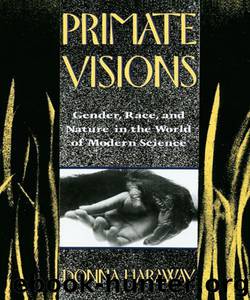Primate Visions: Gender, Race, and Nature in the World of Modern Science by Haraway Donna J

Author:Haraway, Donna J. [Haraway, Donna J.]
Language: eng
Format: epub
ISBN: 9781136608148
Publisher: Taylor and Francis
Published: 2013-01-11T00:00:00+00:00
Would the unique “female researcher” have seen her results as the fruit of natural affinity, or would she with Fedigan have remembered hours of work, perhaps invisible to the men because most of her life was invisible? Was the barrier between Kawai and the female monkeys a lack of natural affinity or the social history of patriarchy?
Kawai went further, and Asquith, a western woman writing a history of primatology, noted his usage in a masterpiece of understatement in a modest footnote. Like Yerkes before him, in a different culture which still somehow fostered male researchers’ feelings of annoyance at female animals seen to take advantage of their sexual politics to curry undeserved favor, Kawai described an incident in which females chased off a high-ranking male, relying on the implicit support of a still higher ranking male. Kawai perceived the females as “swaggering” and “taking advantage of’ their relation to the ascendant male.29 In Adam’s Rib, written between 1941 and 1946, and so the first feminist commentary on the history of primatology, Ruth Herschberger (1970 [1948]: 5–15) had the chimpanzee Josie comment on Yerkes’s similar perceptions in the 1930s. Herschberger, prescient about the dilemma of male observers isolated from women in the field, titled her first chapter ironically, “How To Tell a Woman from a Man.” Between seeing no differences among females and perceiving their actions in terms of his own solidarity with the offended male, Kawai’s description of matrilineal rank structure, supposedly crucial to deposing male dominance hierarchy theory as the explanation of the organization of macaque primate society, makes this reader remember that matrilineal organization is eminently compatible with male power and masculinist standpoints in social theory. The River Ki, a contemporary popular Japanese fiction written by a major Japanese woman author, makes the same point (Ariyoshi 1980).
My concluding moral is simple: Holism, appreciation of intuitive method, presence of “matriarchal” myth systems and histories of women’s cultural innovation, cultivation of emotional and cognitive connection between humans and animals, absence of dualist splits in objects of knowledge, qualitative method subtly integrated with rigorous and long-term quantification, extensive attention to the female social organization as the infrastructure grounding more visible male activities, and lack of culturally reinforced fear of loss of personal boundaries in loving scientific attention to the world are all perfectly compatible with masculinism in epistemology and male dominance in politics. The lessons of Japanese primatology for current analyses in western feminist philosophical and social studies of science are clear on these points. Western science suggests the same message, but perhaps it is more obvious in the context of sharp cultural difference, the sharpest, in fact—that between the mythic world historical structures called “West” and “East.”
Both nineteenth-and twentieth-century western feminist theorists have argued that the self-contained, autonomous, western masculinist self, and the knowledge of the world he produces, is somehow truly opposed by women’s putatively less rigid selves, issuing messages in another voice. The knowledge of the world imagined to come from this point of view, called women’s, is
Download
This site does not store any files on its server. We only index and link to content provided by other sites. Please contact the content providers to delete copyright contents if any and email us, we'll remove relevant links or contents immediately.
| Amphibians | Animal Behavior & Communication |
| Animal Psychology | Ichthyology |
| Invertebrates | Mammals |
| Ornithology | Primatology |
| Reptiles |
Sapiens: A Brief History of Humankind by Yuval Noah Harari(14252)
The Tidewater Tales by John Barth(12608)
Mastermind: How to Think Like Sherlock Holmes by Maria Konnikova(7227)
Do No Harm Stories of Life, Death and Brain Surgery by Henry Marsh(6891)
The Thirst by Nesbo Jo(6826)
Why We Sleep: Unlocking the Power of Sleep and Dreams by Matthew Walker(6618)
Life 3.0: Being Human in the Age of Artificial Intelligence by Tegmark Max(5474)
Sapiens by Yuval Noah Harari(5294)
The Longevity Diet by Valter Longo(5019)
The Body: A Guide for Occupants by Bill Bryson(4974)
The Rules Do Not Apply by Ariel Levy(4861)
The Immortal Life of Henrietta Lacks by Rebecca Skloot(4525)
Animal Frequency by Melissa Alvarez(4395)
Why We Sleep by Matthew Walker(4360)
The Hacking of the American Mind by Robert H. Lustig(4318)
Yoga Anatomy by Kaminoff Leslie(4306)
All Creatures Great and Small by James Herriot(4232)
Double Down (Diary of a Wimpy Kid Book 11) by Jeff Kinney(4207)
Barron's AP Biology by Goldberg M.S. Deborah T(4097)
